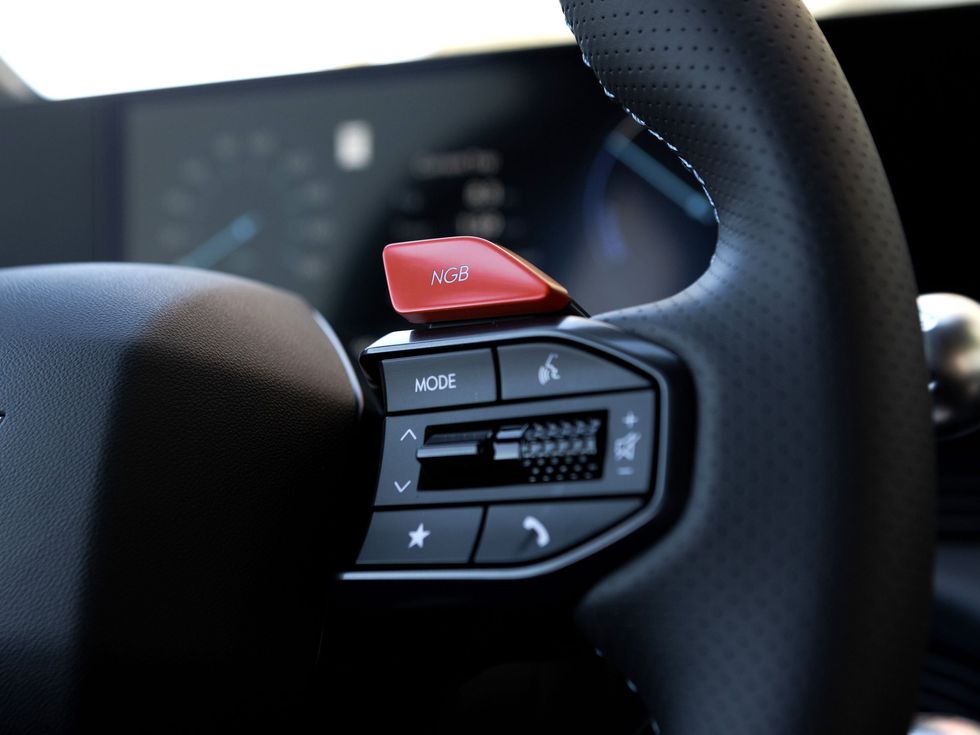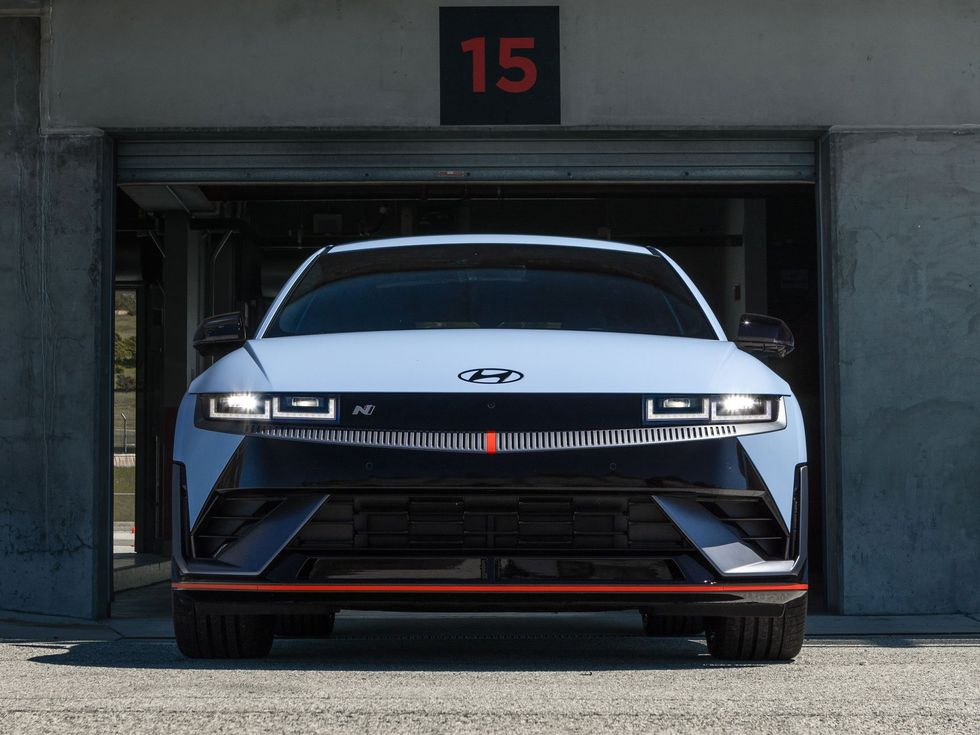Some people will tell you EVs are always more fun-to-drive than internal combustion cars. But performance and racing engineers know that’s not really true. Otherworldly acceleration aside, most EVs suffer from a distinct lack of old-school driving engagement: Numb electric steering, no stirring sounds or gears to shift, and excess weight that dulls handling. Throw in batteries, motors, or energy-saving tires that can’t hold up in extremis, and the result is EVs that feel out of their element when they’re driven to the max.
However, the Hyundai Ioniq 5 N throws down a gauntlet, or specifically a racing glove: Starting from US $67,475, the first electric model from Hyundai’s fast-rising N performance division is specifically engineered to heighten the human connection—and deliver fun and visceral feel on racetracks and winding roads.
To prove it, Hyundai brought me to Laguna Seca Raceway in Monterey, Calif., whose plummeting Corkscrew is one of the world’s most famous corners. Here, Hyundai’s 478 kilowatt crossover SUV delivered a surprisingly vivid impression of a rally-style ICE car. Hyundai engineers did their homework, logging more than 10,000 kilometers of development at Germany’s Nürburgring circuit, a global industry benchmark for performance cars. The Hyundai is designed to knock out two grueling ‘Ring laps, recharge in 18 minutes, and do it all over again. Many EVs can barely manage one ‘Ring lap before they’re wrung dry or overheated.
My own track test includes chasing Paul Dallenbach, the 11-time Pikes Peak International Hill Climb champion, in his own Ioniq 5 N. Later this year, Dallenbach will drive one of two showroom-spec Ioniq 5 N’s up the 156 fate-tempting curves of Pikes Peak, with Hyundai confident it will set a new record for production electric SUVs.
The charmingly angular crossover is based on the Ioniq 5 that has earned robust sales and major automotive awards around the globe. That includes the sophisticated 800-volt e-GMP platform that delivers some of the industry’s fastest DC charging at up to 238 kW. Hyundai then adds robust tech inspired by its World Rally Championship (WRC) cars, along with some world’s firsts for any EV.

The Ioniq 5 N’s first-for-EV achievements
One first concerns the number eight: Like nearly every EV, the Hyundai’s synchronous AC motors only require a single-speed transmission. But the N 3-Shift system digitally simulates the eight forward speeds of a conventional dual-clutch gearbox, via a set of paddle shifters. A digital tachometer soars to a faux 8,000-rpm engine “redline,” synced to a choice of powertrain sounds that rise and fall with vehicle velocity and shifts. (Pay no mind to electric motors that are actually spinning at 21,000 rpm). The simulated transmission feels surprisingly natural, with digitized torque interruptions at each upshift, and rev-matched downshifts. When I wait too long to shift, the Hyundai even bumps up against that artificial redline, stalling forward momentum until I summon an upshift: Just like a “real” ICE car. Shift too soon, and the powertrain lugs and drags, as though you’ve chosen too high a gear.
Digitized sounds are played through 10 speakers—eight inside the car, two outside—with three selectable themes. “Ignition” simulates the sound of Hyundai’s feisty four-cylinder ICE engine. “Evolution” syncs sound, inspired by Hyundai’s RN22e electric prototype, to lateral g-forces during cornering. Finally, a synthesized “Supersonic” theme is inspired by twin-engine fighter jets.
A strengthened chassis brings 42 additional welding points, 6.9 feet of extra structural adhesives, and reinforced mounting points for permanent magnet motors. Higher-density NMC battery cells cram 84 kWh into the same space as the standard Ioniq 5’s 77.4 kWh pack. 21-inch (53.3 cm) forged alloy wheels reduce unsprung weight, shod with sticky Pirelli P Zero performance tires. Rack-mounted electric steering gets a faster ratio.
Rally-inspired integrated drive axles are beefed up for the N version’s lusty horsepower and torque. As I roll from the pits onto the hilly 3.5-km circuit, the Hyundai spins up to 448 kW (601 hp) through its dual electric motors. But pressing a steering wheel button summons a rib-crunching 478 kW (641 hp) through the “N Grin Boost” feature—akin to a Formula 1 car’s “push-to-pass” switch, here in 10-second bursts.
An automated launch control rockets my Ioniq 5 N to 102 kph (60 mph) in a company-claimed 3.2 seconds. But this Hyundai is surely faster: I suspect three seconds flat, perhaps even 2.9. Top speed is 260 kph (162 mph). A state-of-charge algorithm automatically calculates battery consumption every lap. In mellower situations, this N version keeps the Vehicle-to-Load (V2L) capability from a standard Ioniq 5, recharging e-bikes, appliances, and gear even when the car is turned off.
Racing, cooling, and just plain driving
Innovation continues with the “N Race” feature, a motorsports-derived approach to maximum efficiency on track. An Endurance mode limits peak power for slower temperature build-up and longer lapping sessions. For the fastest possible lap times, a Sprint mode sustains maximum power.
The most powerful brakes ever fitted to a Hyundai integrate massive 40-cm front rotors and 36-cm rear rotors. Also developed under the brutal conditions of the Nürburgring “north loop” (Nordschleife), the system helps save mechanical brakes from overheating and fade with an industry-leading 0.6 g’s of electric regeneration to decelerate the car. That regeneration remains engaged even when drivers hammer mechanical brakes hard enough to engage ABS. Fans of left-foot braking—count me among them—will welcome a feature that allows the brake pedal and accelerator to operate simultaneously without cutting power to motors, for smoother transitions between pedals in Laguna’s fiendishly technical corners.
Heat is the enemy for any car on track, regardless of powertrain. Here, Hyundai claims a new electric SUV benchmark for thermal management in track conditions. The N adds independent radiators for its battery and motors, enhanced motor oil cooling and an enlarged battery chiller. A shortened heat transfer route between battery cells and the cooling channel ensures high thermal conductivity. Before we hit the track, I dial the N’s battery pre-conditioning system to a Track mode that summons maximum cooling for sustained lapping.

Like most any EV, the Ioniq 5 N is quite the porker at about 2,205 kilograms (4,860 pounds). Yet between the chassis enhancements and a range of electronic helpers, the Hyundai delivers surprisingly sprightly handling on this historic circuit. An “N Pedal” software function again prioritizes fast reflexes over absolute efficiency, using electric deceleration to aggressively transfer weight onto the car’s front end for sharper cornering.
Versus a standard Ioniq5, the car sits 20 millimeters lower, and grows 51 mm wider to accommodate fat 21-inch forged alloys and tires. Luminous orange trim wraps the entire car, underscoring the aggressive visuals. The front end gets a gaping grille to inhale air, with active air flaps also boosting cooling or trimming drag. Inside the racy cabin, thick-bolstered seats are lowered for a better driving position. Versus the open floor plan of a standard Ioniq 5—remember, there’s no conventional transmission that requires a center tunnel—the N version adds a traditional center console with knee pads to brace drivers in corners.
Choosing performance and track stamina over energy efficiency takes a bite out of real-world driving range. The Ioniq 5 N is EPA rated for just 356 km of range, versus 418 km for standard AWD Ioniq 5’s, and up to 488 km for single-motor versions. Any lingering guilt over burnt rubber or profligate energy use may be eased somewhat by the absence of tailpipe emissions, or a range of sustainable materials inside: Recycled yarn derived from sugarcane and PET bottles, eco-processed leather, or recycled poly seat cloth. More importantly, the Ioniq 5 N ably recycles the hands-on thrills that have gone missing in many EVs.
Lawrence Ulrich is an award-winning auto writer and former chief auto critic at The New York Times and The Detroit Free Press.



